Sony Bravia 3 LED TV assessment
Sony Bravia 3 LED TV Specs
Worth: $599.99
Display measurement: 43 inches
Mannequin: Sony Ok-43S30
Decision: 3,840×2,160
HDR: HDR10, HLG, Dolby Imaginative and prescient
Refresh Fee: 60Hz
Ports: 4x HDMI 2.0, 2x USB 2.0
Audio: 20W
Sensible TV Software program: Google TV
Measurement (with out stand): 38 x 22 1/4 x 2 3/4 inch
Weight (with out stand): 21.9 lb
Bells and whistles are good, however not everyone wants them. That’s the spirit of the all-new Sony Bravia 3, this 12 months’s most inexpensive mannequin within the Bravia TV lineup.
As an entry-level set, the Bravia 3 isn’t overflowing with options, neither is it dripping with fashion. Nonetheless, I do recognize the Bravia 3. It’s not one of many greatest TVs you should buy, however it doesn’t need to be; it’s a good-enough TV for most individuals and it doesn’t value that a lot.
However earlier than you compromise down with Sony’s entry-level Bravia, it’s vital to place it into perspective. Proper now, the 55-inch Bravia 3 will run you about $650 — that’s $100 greater than the 55-inch Hisense U7N, a Mini-LED TV that outperforms the Bravia 3 in a number of key classes. The 55-inch TCL QM7 just lately dropped as little as $500, too, and it additionally affords a superior Mini-LED show.
So, except you’ve bought your coronary heart set on that Sony insignia, you should do some severe soul looking out in regards to the different suitors. The Bravia 3 is a wonderfully cromulent choice, however of us seeking to maximize their greenback on efficiency might simply wring out extra from a competing TV.
Sony Bravia 3 LED TV assessment: Pricing and availability
The Bravia 3 is new for 2024 and broadly accessible. As a result of we’re rapidly approaching end-of-year gross sales on the time of publishing, you possibly can simply discover sale pricing on the Bravia 3, too.
As talked about, the Bravia 3 is the entry-level choice in Sony’s Bravia lineup. It is available in behind the Bravia 7 (a mid-range Mini-LED TV), the Bravia 8 (Sony’s latest OLED TV), and the Bravia 9 (the model’s flagship Mini-LED in 2024). It’s accessible in six measurement choices starting from 43 to 85 inches. Right here’s the sequence at a look:
- Sony Ok-43S30 (43-inch): $599.99 | Sale: $499.99
- Sony Ok-50S30 (50-inch): $699.99 | Sale: $599.99
- Sony Ok-55S30 (55-inch): $849.99 | Sale: $649.99
- Sony Ok-65S30 (65-inch): $999.99 | Sale: $749.99
- Sony Ok-75S30 (75-inch): $1,299.99 | Sale: $949.99
- Sony Ok-85S30 (85-inch): $1,799.99 | Sale: $1,399.99
Whereas we usually don’t anticipate there to be a lot of a distinction between TV sizes belonging to the identical sequence, there will be exceptions. In response to our checks, our assessment unit — a 43-inch Bravia 3 we bought ourselves — options an IPS-style show. Not like VA-style panels, which are inclined to show higher distinction and narrower viewing angles, IPS/ADS-style panels produce shallower black ranges and wider viewing angles.
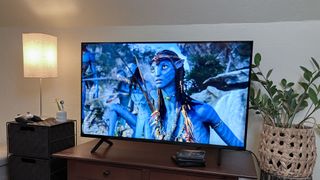
There are stories that the Bravia 3 panel varieties fluctuate by measurement, however with out taking a more in-depth have a look at every of the opposite fashions within the sequence, we are able to’t say for sure which fashions make use of which fashion. A Bravia 3 with VA panel would possibly show higher distinction than what I skilled on our 43-inch mannequin, however finally, I don’t suppose the distinction makes that a lot of a distinction given the remainder of the Bravia 3’s {hardware}.
Unsure which measurement TV you want? Take a look at our ‘What TV measurement do you have to purchase?’ information.
Sony Bravia 3 LED TV assessment: Design
The aesthetic panorama of budget-friendly TVs isn’t a diverse one; for probably the most half, TVs on this worth vary aren’t the type that make statements with attention-grabbing design thrives. The Bravia 3 isn’t any completely different: It’s just about only a black rectangle on toes.
That’s not essentially a mark in opposition to it, although, except you have been anticipating a red-carpet rollout. The Bravia 3 will meet most individuals’s expectations of a TV on this worth vary, and it’ll mix into nearly any dwelling area.
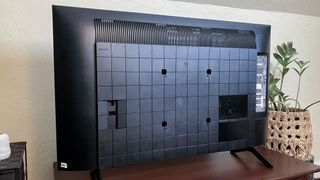
As a result of TV’s direct-LED show kind, the Bravia 3 is beefier than a few of the extra svelte Mini-LED TVs I’ve seen of late, however its panel is about as thick as I used to be anticipating given its inexpensive {hardware} and worth.
It’s price mentioning, although, that Samsung’s entry-level QLED, the Q60D, is way slimmer, regardless of utilizing related {hardware}. In different phrases, you will get a sleeker-looking TV at this worth level.
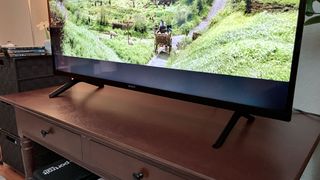
The one different noteworthy side of the Bravia 3’s design is the positioning of its toes. The panel rests atop two wide-set, boomerang-shaped toes, and in contrast to the Bravia 7, 8, and 9 — which provide a number of methods to place their toes — the Bravia 3 solely affords a single configuration. This isn’t a lot of an issue with the 43-, 50-, and even 55-inch fashions, however for those who’re homing in on a 65-, 75-, or 85-inch Bravia 3, make sure that you’ve got a media console that may accommodate the extensive hole between its toes.
Sony Bravia 3 LED TV assessment: Ports
Make a journey across the again of the Bravia 3 and also you’ll discover all of its connectivity choices stacked neatly in a side-facing cutout. You needn’t search for HDMI 2.1 inputs because the Bravia 3 has none.
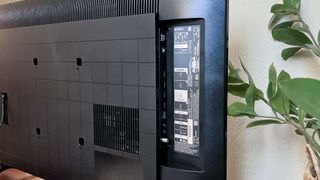
There are 4 HDMI 2.0 inputs (one among which helps eARC), an Ethernet port, an optical digital audio output, an RS-232C port, and a pair of USB ports (one among which is USB 3.0).
Conveniently, the Bravia 3 can also be outfitted with an ATSC 3.0 tuner, that means it is able to obtain a 4K sign throughout choose over-the-air broadcasts. I feel that is quietly one of many Bravia 3’s handiest options, because it’s not assured on this worth vary. Pair it with one of many greatest indoor TV antennas and revel in native sports activities, information, and all the things community TV has to supply. With an ATSC 3.0 tuner, broadcasts in ultra-high definition will meet the Bravia 3’s 4K decision.
Sony Bravia 3 LED TV assessment: How we check
At Tom’s Information, we observe a normal testing protocol for each TV we assessment. Our benchmarks embrace technical and subjective checks designed to charge the set’s efficiency. For our technical checks, we use a Jeti spectraval 1501-HiRes spectroradiometer, a Klein K10-A colorimeter, a Murideo 8K-SIX-G Steel sample generator, and Portrait Shows’ Calman TV-calibration software program to take measurements. We additionally use a Leo Bodnar 4K Enter Lag Tester for figuring out the TV’s gaming prowess.
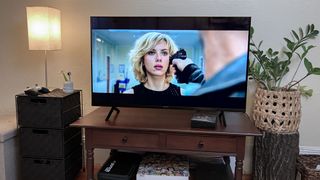
Subjective checks fluctuate primarily based on the reviewer, however normally function anecdotes from a various collection of films, TV reveals, and different content material reflecting the varieties of issues you may very well wish to watch on the TV. For a extra detailed have a look at what we do and the way we do it, take a look at our “How we check TVs” web page.
Sony Bravia 3 LED TV assessment: Efficiency and check outcomes
| Row 0 – Cell 0 | Sony Bravia 3 | Hisense U7N | Samsung Q60D | TCL Q6 |
| SDR Brightness (10%, in nits) | 448 | 531 | 273 | 431 |
| Delta-E (decrease is healthier) | 3.5 | 1.7 | 2.6 | 2.1 |
| Rec. 709 % Gamut Protection | 99.71 | 99.45 | 99.12 | 97.41 |
| HDR Brightness (10%, in nits) | 448 | 1,346 | 422 | 498 |
| UHDA-P3 % Gamut Protection | 95.88 | 92.97 | 90.88 | 94.51 |
| Rec. 2020 % Gamut Protection | 69.81 | 75.32 | 69.53 | 68.92 |
| Enter Lag (ms) | 9.2 | 13.2 | 9.5 | 8.9 |
From a efficiency standpoint, the Bravia 3’s greatest success is that it seems fairly good no matter what you’re participating with, be it Netflix, primary cable, or one of many Blu-rays you’ve got kicking round. What do I imply by “fairly good?” I imply that there’s no odd tinting, lower-resolution content material is upscaled with out a lot artifacting, and issues merely look clear — no less than in Sony’s Skilled image mode (which I extremely suggest that you just use).
You see, the first motive to spring for probably the most inexpensive TVs made by Sony (moderately than probably the most inexpensive TVs made by, say, Insignia) is that Sony holds itself to a better commonplace in relation to the finer particulars of tv engineering. The model is broadly lauded for its distinctive image processing, and it’s straightforward to take that without any consideration till you see your fair proportion of bottom-of-the-barrel TVs from lesser-known manufacturers. (Sorry, Insignia.)
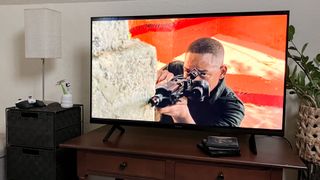
In Sony’s Skilled image mode (previously often called Customized), the Bravia 3 doesn’t simply go the attention check, it’s impressively correct for a TV on this class. Our testing bears this out with arduous information: When measuring in opposition to an SDR coloration gamut, the Bravia 3 produced a Delta-E of round 3.5. This measurement determines perceptible coloration error with a decrease quantity being higher. As a result of a Delta-E of three is the edge of coloration error noticeable to most individuals, I can let you know that this Bravia is maintaining coloration on the extent.
It additionally affords distinctive coloration quantity for its class. Bolstered by quantum dots (or Triluminos Colour, for those who ask Sony), the Bravia 3 covers a commendable 94% of the UHDA-P3 HDR coloration gamut. That’s mighty spectacular in comparison with simply the 84% measurement we pulled from the Samsung Q60D. It even edges out the U7N, which measures in at round 93%.
I did my fair proportion of watching full-HD and even 720p content material on the Bravia 3, and I got here away impressed with the TV’s means to restrict the bizarre, blocky artifacts you typically see on a 4K TV making an attempt to upscale one thing to its native decision. These are the kind of particulars that Sony pays consideration to, and for a TV whose major use case will probably be informal viewing, this consideration to element goes a good distance.
It’s not all excellent news, sadly. The Bravia 3’s Achilles’ heel is its general dimness, particularly when in comparison with equally priced TVs. In response to our check outcomes, it by no means will get a lot brighter than about 450 nits, even in HDR.
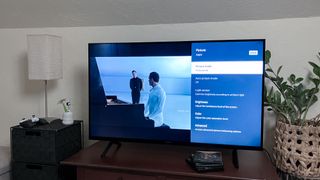
Switching out of my most popular image mode (Skilled) right into a one which I assumed could be brighter (like Customary) didn’t do a lot to enliven the image. The truth is, there’s not a lot of a distinction — no less than in relation to luminance — between what the Bravia 3 outputs in SDR versus HDR.
Much less-impactful HDR apart, it’s moderately obtrusive to have a window anyplace inside line of the Bravia 3’s show, and it’s a downright bummer for the TV to be in a sun-soaked room. It simply doesn’t stand an opportunity. My efforts to observe comparatively darkish films on the Bravia 3 in the course of the day (like “The Northman”) have been rapidly minimize quick once I realized how severely noon ambient gentle was obscuring the image.
That the Bravia 3 lacks any kind of native dimming solely provides to the TV’s contrast-related woes. Think about a brightly lit spacecraft transferring by means of starfield in a science fiction film. With out native dimming, the Bravia 3 can’t show the brilliant spacecraft with out additionally lifting the brightness of the void round it. The deep, darkish, vastness of area seems grey and shallow.
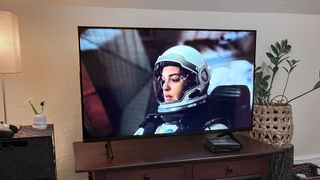
This was exactly my expertise whereas watching a few of the early area journey sequences in “Interstellar.” Even with the lights off after darkish, the darkness of area throughout these sequences seems milky, because the Bravia 3 struggles to maintain the image appropriately darkish whereas driving brightness in direction of the spacecraft.
The dearth of higher show expertise (specifically, native dimming) is the place the Bravia 3 begins to actually lose floor to its competitors. Let’s do just a few thought experiments. If you happen to spend $100 much less on the Hisense U7N, you’ll get much better brightness and general distinction. A ten% HDR window on Hisense’s mid-range Mini-LED produces over 1,000 nits of brightness. That’s a big distinction in your house — particularly for those who intend on placing your subsequent TV in a room that sees a whole lot of daylight.
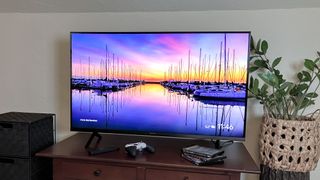
Alternatively, for those who have been to determine that you just don’t thoughts shelling out about $50 extra on a 55-inch Roku Professional Sequence (maybe since you actually dig the Roku good platform), you’d see about double the HDR spotlight brightness, as we clocked a ten% HDR window at near 900 nits on the Professional Sequence.
Each of those TVs — one considerably cheaper and one other priced fifty bucks increased — function Mini-LEDs and native dimming capabilities. They’re higher geared up to showcase that hypothetical area sequence I outlined above, and they’re higher geared up for informal, daytime viewing. Which is a disgrace, as a result of I don’t suppose both the Hisense or the Roku TV are as profitable in relation to upscaling.
The Bravia 3 passes the attention check. Its colours are correct out of the field, and it presents content material cleanly, no matter decision. However its lack of brightness makes it a poor match for bright-room viewing, and even with the lights off, its distinction can’t compete with most of its rivals.
Sony Bravia 3 LED TV assessment: Audio
There’s not a lot to say in regards to the Bravia 3’s on-board audio system. It doesn’t supply a collection of audio presets the best way higher-end Sony TVs do, however you possibly can tweak the TV’s audio with an equalizer and make minor changes to the character of its encompass sound.
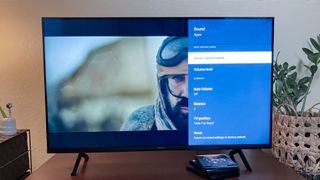
General, I’d describe the Bravia 3’s audio as being a bit on the tinny facet, however I can’t say that I used to be stunned or disenchanted by it. If you wish to lower your expenses on a TV like this and audio is vital to you, I’ll at all times suggest pairing it with one of many greatest soundbars in your worth vary.
As soon as once more, it’s price noting that we have been fairly impressed with the Hisense U7N’s on-board audio. That is one other space during which the Bravia 3 isn’t fairly as much as snuff.
Sony Bravia 3 LED TV assessment: Gaming
You’re not getting a lot in the best way of gaming options with the Bravia 3, however for the informal crowd, it could be enough. Its native refresh charge is 60Hz and it’s not outfitted with HDMI 2.1 inputs, so the Bravia 3 can’t make the most of current-gen consoles that output 4K video games at 120Hz.
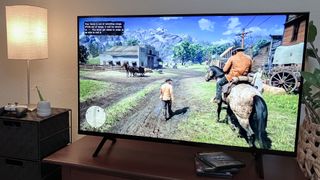
The Bravia 3 additionally lacks Variable Refresh Fee (VRR) and most of the enhancements you will discover on aggressive TVs, like AMD FreeSync and Nvidia G-Sync. It does, nonetheless, assist Auto Low Latency Mode (ALLM), a course of that routinely optimizes the TV for gaming each time it detects a gaming machine.
We did measure an enter lag studying of simply 9.8ms, which makes the Bravia 3 a fairly snappy companion for those who occur to specialise in twitchy, fast-paced video games. Finally, although, the gaming facet of issues tells an identical story because the TV’s general efficiency: There are higher TVs on the market for roughly the identical worth as — and even lower than — the Bravia 3.
Sony Bravia 3 LED TV assessment: Sensible options
I’m joyful to report that the Bravia 3’s Google TV implementation is one among its greatest qualities, if solely as a result of it fulfills an vital position of offering the entire streaming choices one would possibly want in a really easy-to-navigate interface. By and enormous, I think that folk buying in entry-level or mid-range worth factors usually tend to lean on their TV’s built-in options moderately than complicating issues with an exterior streaming machine, and Google TV ensures that this may be carried out simply and with out a lot thought.
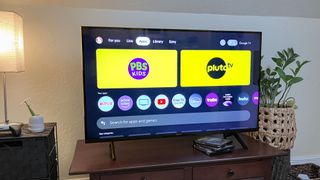
Google TV is snappy and integrates nicely with Sony’s collection of settings menus. It additionally affords an unlimited library of downloadable apps together with the entire greatest streaming companies.
You’ll need to take care of a glut of really helpful and sponsored content material, however that is true for LG’s webOS, Samsung’s Tizen OS, and Amazon Fireplace TV, too. If you happen to’d desire that your Bravia 3 stay freed from personalised content material, you would at all times allow Google TV’s Apps Solely mode.
Sony Bravia 3 LED TV assessment: Distant
The clicker included with the Bravia 3 is much like the one which ships with the Bravia 8 and Bravia 9: a slim wand with simply distinguishable buttons, together with a number of on the backside devoted to numerous apps.
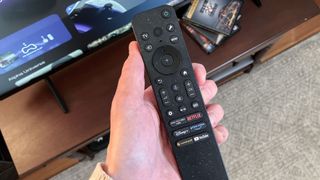
There’s one main distinction: The distant management that comes with the Bravia 8 and 9 encompasses a backlight, which is a significant quality-of-life enchancment over the Bravia 3’s distant.
I ought to emphasize that I a lot desire the Bravia 3 distant — lack of a backlight and all — over the distant controls that include equally priced TVs from Roku and Samsung. Nevertheless, Hisense and TCL have begun rolling out backlight remotes lately, even with their extra inexpensive fashions. It’d be good if Sony adopted swimsuit.
Sony Bravia 3 LED TV assessment: Verdict
Now that I’ve spent an excellent period of time explaining how the Bravia 3 falls in need of aggressive TVs on this worth vary, you could be questioning, “Simply who the heck this TV is for?”
Ideally, the Bravia 3 is a good smallish TV within the 43-inch to 50-inch vary for people who don’t wish to spend an excessive amount of on options they don’t want, however who nonetheless worth the experience that Sony’s engineering workforce brings to sure areas of efficiency — specifically, clear upscaling and an correct presentation, whatever the content material supply.
The Bravia 3’s situation is that almost all of this crowd – the oldsters who care about Sony engineering — are additionally extra more likely to be hip to the truth that distinction is a cornerstone of image high quality. For these customers, the brighter, higher-contrast expertise of a Hisense U7N, a TCL QM7, or perhaps a Roku Professional Sequence will certainly be tempting, particularly since they value as a lot as (and even lower than) the Bravia 3.
I recognize that the Bravia 3 exists for individuals who could be dedicated to the Sony model, however to be able to justify itself, it should both carry out higher, value much less, or each.






